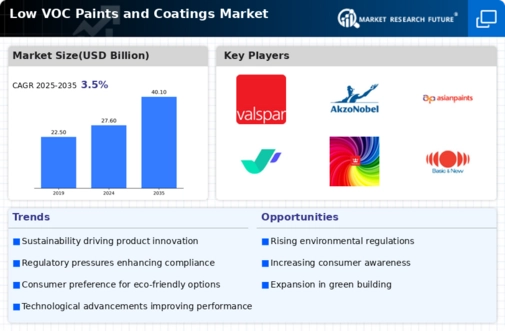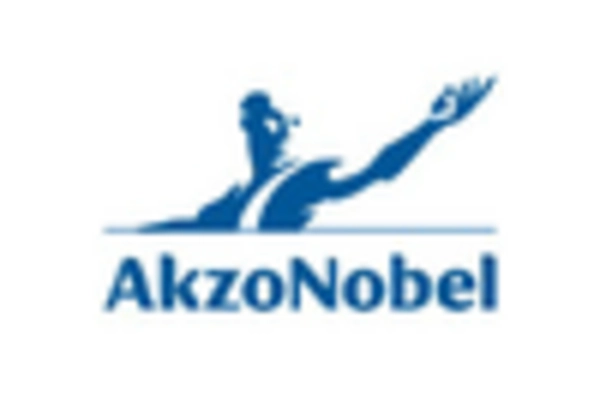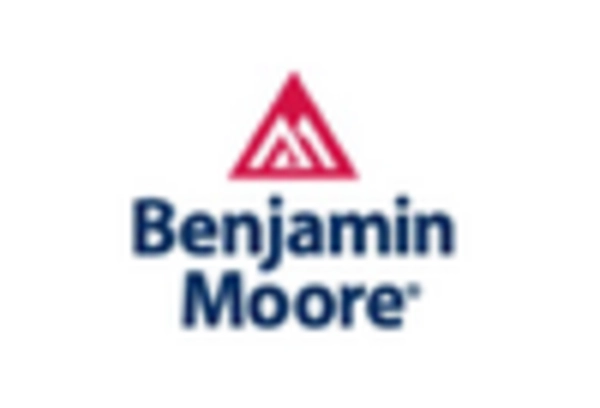Stringent Regulatory Frameworks
The implementation of stringent regulations concerning VOC emissions is a significant driver for the Low VOC Paints and Coatings Market. Governments across various regions have established guidelines aimed at reducing air pollution and promoting healthier indoor environments. These regulations often mandate the use of low VOC products in both residential and commercial applications. For instance, certain jurisdictions have set maximum allowable VOC levels for paints, effectively pushing manufacturers to reformulate their products. This regulatory landscape not only fosters compliance but also encourages innovation within the industry. Market data suggests that regions with stricter regulations have witnessed a 20% increase in the adoption of low VOC paints, indicating that regulatory measures are likely to continue shaping the market dynamics.
Increased Environmental Awareness
The rising consciousness regarding environmental issues appears to be a pivotal driver for the Low VOC Paints and Coatings Market. Consumers and businesses alike are increasingly prioritizing eco-friendly products, leading to a surge in demand for low volatile organic compound (VOC) options. This shift is not merely a trend; it reflects a broader societal movement towards sustainability. As a result, manufacturers are compelled to innovate and expand their product lines to include low VOC alternatives. Market data indicates that the demand for low VOC paints has grown by approximately 15% annually, suggesting a robust market trajectory. This heightened awareness is likely to continue influencing purchasing decisions, thereby propelling the Low VOC Paints and Coatings Market forward.
Expansion of Green Building Initiatives
The expansion of green building initiatives is significantly influencing the Low VOC Paints and Coatings Market. As construction practices evolve towards sustainability, there is a growing emphasis on using materials that comply with green building standards. Low VOC paints are often a requirement for certification under various green building programs, such as LEED (Leadership in Energy and Environmental Design). This trend is not only limited to new constructions but also extends to renovations and retrofitting projects. The market is responding to this demand by increasing the availability of low VOC products that meet these stringent criteria. Market data suggests that the green building sector is projected to grow by 25% over the next five years, indicating a robust opportunity for low VOC paints to capture a larger share of the market.
Technological Innovations in Formulation
Technological advancements in paint formulation are driving the evolution of the Low VOC Paints and Coatings Market. Innovations in chemistry and materials science have enabled manufacturers to develop high-performance low VOC products that meet consumer expectations for durability and aesthetic appeal. These advancements include the use of bio-based solvents and advanced polymer technologies, which enhance the performance of low VOC paints without compromising on quality. As a result, the market is witnessing a diversification of product offerings, catering to various applications from residential to industrial. Market data reveals that the segment of low VOC coatings has expanded by 10% due to these technological innovations, suggesting that ongoing research and development will likely continue to play a crucial role in shaping the future of the industry.
Growing Demand for Healthier Indoor Environments
The increasing demand for healthier indoor environments is emerging as a key driver for the Low VOC Paints and Coatings Market. As awareness of the health impacts associated with traditional paints grows, consumers are actively seeking alternatives that minimize exposure to harmful chemicals. Low VOC paints are perceived as safer options, particularly for residential spaces, schools, and healthcare facilities. This trend is further amplified by the rise in home improvement projects and renovations, where consumers prioritize health and safety. Market data indicates that the segment for low VOC interior paints has seen a growth rate of approximately 12% annually, reflecting a shift in consumer preferences towards products that contribute to better indoor air quality. This demand is likely to persist, reinforcing the importance of low VOC options in the market.


















Leave a Comment